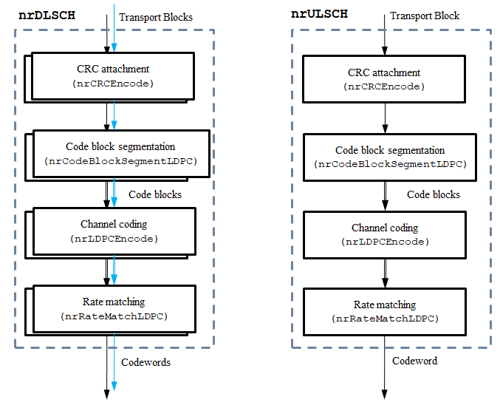Introduction
In 5G NR, the low-density parity-check (LDPC) coding chain for the downlink and uplink shared transport channels (DL-SCH and UL-SCH).
Shared Channel Parameters
The parameters for a transport block transmitted on the downlink shared (DL-SCH) channel.
A = 10000; % Transport block length, positive integer
rate = 449/1024; % Target code rate, 0<R<1
rv = 0; % Redundancy version, 0-3
modulation = 'QPSK'; % Modulation
scheme, QPSK, 16QAM, 64QAM, 256QAM
nlayers = 1; % Number of layers, 1-4 for a transport block
DL-SCH coding parameters
CRC: '24A'
L: 24
BGN: 1
C: 2
Lcb: 24
F: 244
Zc: 240
K: 5280
N: 15840
DL-SCH supports multi-codeword transmission (i.e. two transport blocks) while UL-SCH supports only a single codeword. UL-SCH also supports pi/2-BPSK modulation in addition to those listed above for DL-SCH.
Transport Block Processing using LDPC Coding
Data delivered from the MAC layer to the physical layer is termed as a transport block. For the downlink shared channel (DL-SCH), a transport block goes through the processing stages of:
- CRC attachment,
- Code block segmentation and code block CRC attachment,
- Channel coding using LDPC,
- Rate matching and code block concatenation
before being passed on to the physical downlink shared channel (PDSCH) for scrambling, modulation, layer mapping and resource/antenna mapping.
The output number of bits from the rate matching and code block concatenation process must match the bit capacity of the PDSCH, based on the available resources.
Similar processing applies for the UL-SCH, where the physical uplink shared channel (PUSCH) is the recipient of the UL-SCH codeword. The following schematics depict the processing for the two channels.

% Random transport block data generation
in = randi([0 1],A,1,'int8');
% Transport block CRC attachment
tbIn = nrCRCEncode(in,cbsInfo.CRC);
% Code block segmentation and CRC attachment
cbsIn = nrCodeBlockSegmentLDPC(tbIn,cbsInfo.BGN);
% LDPC encoding
enc = nrLDPCEncode(cbsIn,cbsInfo.BGN);
% Rate matching and code block concatenation
outlen = ceil(A/rate);
chIn = nrRateMatchLDPC(enc,outlen,rv,modulation,nlayers);
Wireless Channel
With the full PDSCH or PUSCH processing, one can consider fading channels, AWGN and other RF impairments as well.
Receive Processing using LDPC Decoding
The receive end processing for the DL-SCH channel comprises of the corresponding dual operations to the transmit end that include
- Rate recovery
- LDPC decoding
- Code block de-segmentation and CRC decoding
- Transport block CRC decoding
%
Rate recovery
raterec = nrRateRecoverLDPC(chOut,A,rate,rv,modulation,nlayers);
% LDPC decoding
decBits = nrLDPCDecode(raterec,cbsInfo.BGN,25);
% Code block de-segmentation and CRC decoding
[blk,blkErr] = nrCodeBlockDesegmentLDPC(decBits,cbsInfo.BGN,A+cbsInfo.L);
% Transport block CRC decoding
[out,tbErr] = nrCRCDecode(blk,cbsInfo.CRC);
Note that there are two level of CRC check are performed: One the TB level CRC check, the other is the CB level CRC check.
CRC error per code-block: [0 0]
Transport block CRC error: 0
Reference,
MathWorks